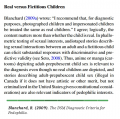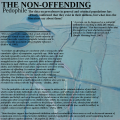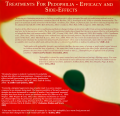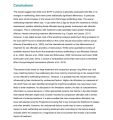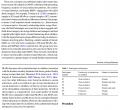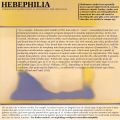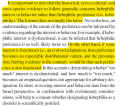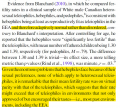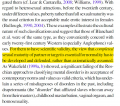Research: A "cure" for pedophilia?
 | ||||||||||||
| Part of NewgonWiki's research project | ||||||||||||
|---|---|---|---|---|---|---|---|---|---|---|---|---|
|
| ||||||||||||
| ||||||||||||
|
| ||||||||||||
| Template: Research - This template |
Attempts to "treat" pedophilia are ineffectual and in many cases harmful. It's important to point out that pedophilia is the direction of one's sexuality, not the intensity of one's sexual interest. While there are drugs that can reduce sexual desire, reorientation is not possible.
Treatment
Efficacy
- Stelzmann, D., Jahnke, S., & Kuhle, L. F. (2022). Media Coverage of Pedophilia and Its Impact on Help-Seeking Persons with Pedophilia in Germany - A Focus Group Study. International Journal of Environmental Research and Public Health 19 (15), DOI: 10.3390/ijerph19159356
- “Both sexual preferences for prepubescent (pedophilia) and pubescent (hebephilia) children are only considered pathological if the sexual attraction to children resulted in previous sexual offending against children, or causes significant distress and/or interpersonal difficulties (pedophilic disorder or unspecified paraphilic disorder [10]). Currently, there is little evidence showing that the sexual attraction to children can be “cured” in the sense that it can be converted into a sexual attraction to adults (teleiophilia; overview see [23]). Therefore, preventive treatment often focuses on behavioral control and/or the reduction of psychological distress.”
- Berlin, Fred S. (2000). "Treatments to Change Sexual Orientation," American Journal of Psychiatry, 157, p. 838.
- "It may be no easier for a person with pedophilia to change his or her sexual orientation than it is for a homosexual or heterosexual individual to do so."
- Howitt, D. (1995). "The Treatment of Paedophiles," in Paedophiles and Sexual Offences Against Children, pp. 189-192.
- "Many of the early behaviour therapy treatments for paedophilia emerged from attempts to make homosexuals "normal" or, at least, stop "doing their thing". [...] As we will see, there is a degree of uncertainty about the effectiveness of even the best researched therapies for paedophiles. There are a number of reasons for this. Many of the therapies have not been subject to specific empirical evaluation of any sort; some have been tried with only a few clients. Often the criteria of therapeutic success have fallen well short of evidence of a decline in recidivism in offending, obviously one of the most important criteria. Research that includes a control or an alternatively treated group is in the minority of the evaluations. With a situation like this, claims of therapeutic success may sometimes be wishful thinking on the part of the clinician, the client or both."
- Van-Zessen, G. (1990). "A model for group counseling with male pedophiles," Journal of Homosexuality, 20(1-2), 189-198.
- "The majority of the reported studies have roots in behavior therapy. The early behavioral approaches were aimed at reducing the deviant sexual arousal by aversion therapy (Quinsey et al., 1976). The attraction to children is viewed as purely sexual (Howells, 1979). In its simplest form, the child is the stimulus that elicits sexual excitement in the adult (Quinsey et al., 1975). All other motivations and meanings of pedophile attraction are ignored. [...] In an overview of the literature concerning homosexual conversion therapies, James (1978) concluded that the majority of studies were unsuccessful in changing sexual orientation. It is likely that the same holds for pedophile conversion therapy."
- Seto, M. (2009). "Pedophilia," Annual Review of Clinical Psychology, 5, 391-407.
- "There is no evidence to suggest that pedophilia can be changed. [...] Across the following interventions, the underlying assumption is that pedophilia is a stable sexual preference that is unlikely to change, just as there is little, if any, evidence that heterosexual or homosexual orientation can be changed. Recent etiological research on neurodevelopmental correlates of pedophilia—including cognitive functioning, non-right-handedness, and structural volume differences—suggests that pedophilia is influenced by prenatal factors and thus is unlikely to respond to interventions delivered when the individual is an adult (e.g., Cantor et al. 2008)."
- Quinsey, V. L. (2008). "Seeking Enlightenment on the Dark Side of Psychology," Trauma, Violence, & Abuse, 9(2), 72-83.
- "Sexual age and gender preferences do not appear to be learned and malleable (e.g., our attempts to increase sexual arousal of normal subjects to slides of women through Pavlovian conditioning by pairing the slides with highly arousing videotapes were vitiated by habituation; Lalumière & Quinsey, 1998). Although sexual age and gender preferences can be measured with phallometric technology (for reviews of the assessment and treatment literature on sexual offenders against children, see Camilleri & Quinsey, in press; Quinsey & Lalumière, 2001) and responses to deviant categories can be reduced with standard conditioning techniques, these alterations now appear not to involve the preferences themselves but only their measurement. Fifty years after Kinsey et al. (1953) wrote the passage quoted at the beginning of this section, it appears that the role of learning in the development of sexual age and gender preferences is limited or nonexistent (for a review, see Quinsey, 2003)."
- Berlin, Fred S., Saleh, Fabian M., and Malin, H. Martin (2009). "Mental Illness and Sex Offending," in Sex Offenders, p. 124. Oxford University Press US.
- "In the past, efforts to "recondition" homosexuality were a clear failure. The same would appear to be true of methods intended to "recondition" paraphilic conditions such as pedophilia."
- Camilleri, Joseph A., and Quinsey, Vernon L. (2008). "Pedophilia: Assessment and Treatment," in D. Richard Laws and William T. O'Donohue (eds.), Sexual Deviance, Second Edition.
- "The greatest problems with conditioning approaches (and other approaches described later) are (1) that changing actual preferences (as opposed to indices that reflect them) has been quite difficult (Furby, Weinrott, & Blackshaw, 1989; Lalumière & Quinsey, 1998); and (2) no studies have shown long-term changes in sexual preference or behavior after treatment (Laws, 2001; Quinsey & Earls, 1990). [p. 193] [...] Despite the strong relationship between neurobiological variables in sexual behavior and treatment, reducing general arousal does not alter sexual preference. Researchers found that men with phallometrically measured deviant sexual interests had the same preferences after hormonal treatment (Bancroft, Tennent, Loucas, & Cass, 1974; Cooper, Sandhu, Losztyn, & Cernovsky, 1992). [...] It appears as though treatment for paraphilias works by decreasing sexual interest in general, suggesting that medical treatments do not "cure" the sexual preference but mask it by reducing sexual desire. [p. 200]"
- 12/11/06 deposition of Michael B. First, M.D., in In Re the Detention of William Davenport AKA William Cummings, Franklin County, Washington, No. 99-2-50349-2.
- "I was the editor of the DSM-IV-TR. DSM-IV-TR was published in the year 2000. I was also the editor of the text and criteria of its immediate predecessor, which was the DSM-IV. [p. 9] [...] If you're attracted to children at age 13 you’re going to be attracted to children at age 70. [...] The fact that that's your focus of arousal remains constant. [...] The percentage of time you think about that would decline. [...] The time you spend masturbating thinking about that will go down, and the actual paraphilic behaviors go down, but the core of the paraphilia is present for life. There's no evidence, even when you have successful treatment of an individual paraphilia, which actually treating is the intensity of the paraphilia, not the arousal pattern. I don't believe there’s strong evidence that you could actually get someone who is attracted to children to lose [his or her] attraction. [p. 230]"
- American Psychiatric Association (2013). Diagnostic and Statistical Manual of Mental Disorders (Fifth ed.), p. 698.
- "Adult males with pedophilic disorder may indicate that they become aware of strong or preferential sexual interest in children around the time of puberty — the same time frame in which males who later prefer physically mature partners became aware of their sexual interest in women or men. [...] Pedophilia per se appears to be a lifelong condition."
- Seto, Michael (2012). "Is Pedophilia a Sexual Orientation?", Archives of Sexual Behaviour, 41, p. 233.
- "Pedophilia is viewed by many researchers and clinicians as having a lifelong course. For some individuals, at least, it is discovered in early adolescence and sexual interest in children can be detected in adolescence (Seto, Lalumiere, & Blanchard, 2000; Seto, Murphy, Page, & Ennis, 2003); once identified, pedophilia can predict detected sexual behavior involving children up to 40 years later (Hanson, Steffy, & Gauthier, 1993). Changes in sexual arousal to children can be made using behavioral conditioning techniques, but follow-up studies have not shown evidence that this change generalizes outside the laboratory or persists over the longer-term."
- Chronos, Agatha & Jahnke, Sara & Blagden, Nicholas. (2024). The Treatment Needs and Experiences of Pedohebephiles: A Systematic Review. Archives of Sexual Behavior. 1-18. 10.1007/s10508-024-02943-0.
- "Multiple studies (see Table 4) reported that participants had sought or wanted to seek help with the goal of changing their attraction to children. However, as time went on, many came to realize that their attractions were enduring and redirected their goals towards managing them and finding ways to live productive and meaningful lives"
Harm
- Gieles, Frans (2001). "Helping people with pedophilic feelings." Lecture at the 15th World Congress of Sexology, Paris, June 2001.
- "I have met clients who started this kind of treatment [to 'cure' their pedophilia] as a warm lively person and who have been changed into 'a stiff wooden doll' after it."
- Fog, Agner (1992). "Paraphilias and Therapy," Nordisk Sexologi, 10(4), pp. 236-242.
- Fog interviews a pedophile: "My sexual feelings for boys went away partially for about a year, and then at the end of the year I started waking up screaming and hollering with nightmares, and I would see a pitful of snakes and they were just everywhere and I would be screaming to get away from them. [...] 'Were your feelings towards boys reduced by the therapy?' They were reduced in the sense that my penis did not show the difference, but I still enjoyed being a teacher because I could be close to boys. I really don't think that feelings for boys or whoever we have feelings for has all that much to do with how much erection you have, but this is what they were reducing it to. [...] rather than destroy my feelings towards boys they destroyed me as an individual, it destroyed my security."
- Camilleri, Joseph A., and Quinsey, Vernon L. (2008). "Pedophilia: Assessment and Treatment," in D. Richard Laws and William T. O'Donohue (eds.), Sexual Deviance, Second Edition, p. 200.
- "Drawbacks unique to medical treatments for pedophilia include side effects and noncompliance. Commonly cited side effects include hypertension, hyperglycemia, feminization, depression, and headaches (Hill et al., 2003; Saleh & Guidry, 2003)."
- Johnston, Lucy, Hudson, Stephen M., and Ward, Tony (1997). "The suppression of sexual thoughts by child molesters: A preliminary investigation," Sexual Abuse: A Journal of Research and Treatment, 9(4), 303-319.
- "Ironically, attempted suppression may actually result in a worse situation compared to no attempts being made. The hyperaccessibility of formerly undesired thoughts has been documented in a number of studies. Once suppressed, unwanted thoughts have been shown to return and dominate mental life (Macrae et al., 1994; Wegner, 1989; Wegner & Gold, 1995). Once inhibitory mechanisms are relaxed this rebound effect may be pernicious, promoting the execution of maladaptive behaviors, such as binge eating. (Herman & Polivy, 1993) and, potentially, sexual offenses (Johnston, Ward, & Hudson, 1997). [...] However, prior suppression resulted in slower latencies for both the sex-related and the child-related words for the preferential child molesters than either the situational child molesters or the nonsexual offenders, who did not differ from one another. Thought suppression did, then, have greater subsequent effects on the preferential child molesters, as predicted. For some offender types at least, suppression results in greater accessibility of sex-related thoughts. Such rebound effects lead one to question the utility of thought suppression as a therapy technique."
- Chronos, Agatha & Jahnke, Sara & Blagden, Nicholas. (2024). The Treatment Needs and Experiences of Pedohebephiles: A Systematic Review. Archives of Sexual Behavior. 1-18. 10.1007/s10508-024-02943-0.
- "Participants from studies classified as clinical, forensic, or mixed, reported on experiences with chemical treatments such as androgen deprivation therapy (Boons et al., 2021) or gonadotropin releasing hormone antagonists (Landgren et al., 2020). In these cases, positive experiences were largely reported to be the calming effects of the chemicals, abstinence from offending, and improved mental health and well-being. The negative experiences included physical side effects, depression, and guilt. Interestingly, within these samples, the inability to become aroused was reported as a positive treatment effect by some and a negative treatment effect by others."
- McPhail, I.V. (2020) Conceptual and empirical issues in pedohebephilic interest [dissertation]. Saskatoon (SK): University of Saskatchewan
- "The findings that psychotherapy can help men with higher levels of pedophilic interest change joins a growing body of research suggesting that psychotherapeutic approaches can benefit even those with the most severe symptomatology (Furukawa et al., 2017). In the case of interventions for pedohebephilic interests in men with sexual offense histories, this may be an especially positive development, as the side-effects of long-term anti-androgen use can be debilitating and life threatening (Nota et al., 2019; Turner & Briken, 2018). However, it is important to note that at present, there is little to no information regarding adverse reactions clients have to behavioural treatments for pedophilic interest."
- "However, across the studies, a large number of men received these specialized interventions for managing arousal to children who may not have experienced a need in this domain [...] Given the potential adverse reactions to aversive interventions, clients are subjected to potentially harmful and distressing treatments that they do not require"
- Consider this in light of the following: "Approximately half of the analyses supported the conclusion that men who underwent treatment showed levels of arousal to children that were similar to men with no history of sexual offending against children. While this is not unequivocal evidence, [...] it provides some support for the conclusion that offending men do show similar levels of arousal compared to non-offending men."
- Turner, D., & Briken, P. (2018). Treatment of paraphilic disorders in sexual offenders or men with a risk of sexual offending with luteinizing hormone-releasing hormone agonists: An updated systematic review. The Journal of Sexual Medicine, 15, 77–93. doi:10.1016/j.jsxm.2017.11.013.
- "Steroidal antiandrogens and LHRH-agonists have in common that they suppress serum testosterone concentrations via different mechanisms and are thus summarized under the term androgen deprivation therapy (ADT)."
- "Side effects occurring most frequently are fatigue, hot flashes, depressive mood, weight gain, high blood pressure, diabetes, gynecomastia, loss of erectile function, and a loss in bone mineral density. [...] Although LHRH-agonists seem to be the most effective drugs in the treatment of paraphilic fantasies and behaviors, they should be reserved for paraphilic patients with the highest risk of sexual offending because of their extensive side effects."
- "Current studies suggest that LHRH-agonists might be the most effective drugs to decrease paraphilic sexual fantasies, urges, and behaviors. This accounts for adult, adolescent, and sexual offenders with a mental retardation. [...] LHRH-agonists should be reserved for most severe cases of (paraphilic) sexual offenders because they frequently lead to a complete decline of all sexual behaviors, thereby inferring with fundamental human rights. This clarifies that LHRHagonists should not be used with the intention of lifelong treatment and the possibility of ending treatment when adequate should be closely monitored."
Is pedophilia a choice?
- Berlin, Fred S. (2002). "Peer Commentaries on Green (2002) and Schmidt (2002): Pedophilia: When Is a Difference a Disorder?," Archives of Sexual Behavior, 31(6), 479-480.
- "It is likely that no one would choose voluntarily to develop a pedophilic sexual orientation. Those with such an orientation have no more decided to have it than have any of us decided as children to be either heterosexual or homosexual. Men with pedophilia get erections when fantasizing about children. Heterosexual men get erections when fantasizing about women. In neither case is that so because the individual in question has somehow decided ahead of time to program his mind to work in such a fashion. Persons with pedophilia have simply not chosen to experience an alternative state of mind."
- Fagan, Peter J.; Wise, Thomas N.; Schmidt, Chester W.; and Berlin, Fred S. (2002) "Pedophilia," Journal of the American Medical Association, 288, 2458-2465.
- "During psychosexual development, no one decides whether to be attracted to women, men, girls, or boys. Rather, individuals discover the types of persons they are sexually attracted to, ie, their sexual orientation."
Early development
- B4U-Act (2011). "Survey Results".
- "Question: Looking back now, how old were you when you first had a preferential attraction to boys or girls younger than yourself, whether or not you realized it at the time? Result: Of 192 respondents answering this question, the most common age of first attraction was 12. Eighty-five percent began to experience the attraction while still minors themselves."
- Freund, K. & Kuban, M. (1993). "Toward a testable developmental model of pedophilia: The development of erotic age preference," Child Abuse & Neglect, 17, 315-324.
- "[A] greater proportion of pedophiles than of individuals who prefer physically mature partners remembers curiosity in their own childhood to see nude children without remembering such curiosity in regard to adults. This suggests that in a substantial proportion of pedophiles the occurrence of this paraphilia is predetermined at a very early developmental phase." (From abstract.)
- Griesemer, Michael M. (2004). Ausmass und Auswirkungen massenmedialer Desinformation zum Stand der Wissenschaften über sexuellen Kindesmissbrauch. Ipce translation.
- "Rather, we see another astonishing fact: on the same age in pre-puberty, on which the attraction to boys or girls was reported, already the nine years olds of both groups differ. The later pedophiles distinguish themselves from the control group because their objects of attraction are dramatically younger then themselves -- on the average two years younger, while the later non-pedophiles tend to feel attracted to older children -- on average 10.8 years of age.
- Given the data, as now gathered, one might conclude that pedophilia develops itself already on a pre-pubertal age -- although we don't know how."
Psychological wellbeing for MAPs
- See also: Effects of stigma on MAPs
Attraction does not require treatment, but MAPs often need help in improving their mental well-being. Mental health services and professionals may face the following challenges: high levels of anxiety, depression and other conditions in MAPs, severe stigma (for both clients and those who provide compassionate approach), preventionism, attempts at conversion therapy, difficulties in choosing the right therapeutic targets (discrepancies between lay professional beliefs and client's needs), ethics of communication with the client, and mandatory reporting laws. The following excerpts provide information about complications of mental health services as well as evidence-based implications for well-being-focused treatment.
Treatment suggestions derived from the studies include:
- treatment facilities’ shift from prevention to well-being focus
- adjusting prevention effort to the real risk or harm of the offence
- acceptance of the attraction, refusal of conversion attempts
- developing self-compassion, shame reduction
- finding ways of acceptable experiencing one's sexuality, usage of artificial means for sexual satisfaction such as AI products or sex dolls
- undermining overly rigid avoidant coping strategies such as thought suppression and identity concealment
- creating positive self view (self identity, including sexual identity)
- disclosure in supportive contexts
- engaging with a supportive network/ community
- focusing on what is important in life to the individual
- Lievesley, R., Harper, C. A., & Elliot, H. (2020). The internalization of social stigma among minor-attracted persons: Implications for treatment. Archives of Sexual Behaviour, 49, 1291-1304. doi: 10.1007/s10508-019-01569-x
- Harmful mechanism of avoidance strategies:
- "We found that increased levels of suppression and lower levels of psychological well-being were associated with lower levels of hope about the future, but higher levels of both shame and guilt about having a sexual interest in minors. Thought suppression [...] did significantly predict higher rates of actively avoiding children. [...] Independently, lower levels of self-reported psychological wellbeing were associated with a desire for more support and higher rates of actively avoiding children."
- "The internalization of negative social attitudes [...] [is] being posited as a motivation to engage in stress-ameliorating strategies in the form of distancing oneself from the minority identity via concealment (hiding one’s identity from those external to oneself), and suppression (refusing to accept one’s own minority identity)."
- "Smart and Wegner (2000) describe many cognitive burdens that are associated with the constant suppression of one’s identity. Having to maintain an outward appearance that is different to internal processes can lead to a preoccupation with suppressing (Meyer, 2003), which can lead the individual living an internal “private hell” (Smart & Wegner, 2000, p. 229). This may be especially the case among MAPs [...] [S]uppression could become a totalizing experience in all areas of life with profoundly negative efects on psychological well-being. This is particularly troubling in light of evidence of a potential rebound efect that is associated with suppressing unwanted thoughts. Erskine and Georgiou (2011) described a range of evidence, suggesting that trying not to think about particular things (e.g., memories or actions) may actually increase rumination on those topics and reduce self-regulation processes (see also Abramowitz, Tolin, & Street, 2001). For example, dieters who suppress thoughts of hunger or thirst have been found to eat less in the short term, but binge at a later time (Denzler, Förster, Liberman, & Rozenman, 2010; Erskine, 2008), while the same outcomes are observed among smokers trying to reduce their cigarette consumption (Erskine, Georgiou, & Kvavilashvili, 2010). In the sexual domain, suppressing sexual thoughts has been associated with higher levels of compulsive sexual behaviors in religious groups (Efrati, 2019). [...] That is, [...] thought suppression related to minor attraction could paradoxically increase a propensity to engage with sexual thoughts involving children."
- "Prevention" projects impose negative self-view and are therefore ineffective:
- "As reported previously, Grady et al. (2019) found that MAPs who viewed themselves as inherently bad people (they referred to this as shame in relation to sexual attractions) were less likely to seek help from professionals for issues arising from their attractions to minors. [...] Schemes that are designed to prevent or reduce the incidence of child sexual abuse (e.g., Germany’s Dunkelfeld Project) have been evaluated in relation to risk-relevant outcomes and dynamic sexual ofense risk factors (e.g., pro-criminal attitudes, impression management, and delinquent behavior; Beier et al., 2009, 2015), with these not showing particularly the positive results (see Mokros & Banse, 2019). While this lack of “treatment success” may call into question the validity of such schemes, it may be that these schemes emerge as being much more successful if broader psychosocial constructs related to well-being were also assessed. Further, the risk-based framing of such schemes (i.e., “prevention projects”) implicitly assumes that MAPs need to be “prevented” from offending (Lievesley & Harper, 2019), rather than “supported” though their psychosocial experiences of being attracted to minors (Grady et al., 2019; Jahnke, 2018b; Jahnke et al., 2015b). [...] [T]hose wishing to distance themselves from such a label do not reach out to access services that could lead to signifcant well-being improvements (Lievesley & Harper, 2019)."
- "That is, the emphasis of treatment should be less related to “risk reduction” and more related to promoting MAPs’ social and psychological well-being, with forensic risk reduction becoming a by-product of this broader aim. [...] Instead of taking a deficits-focused view of the problem at hand (i.e., adopting a risk-focused lens), acceptance-based approaches such as Acceptance and Commitment Therapy (ACT; Hayes, Strosahl, & Wilson, 1999; Hayes & Wilson, 1994) work with the idea that peoples’ difficulties occur when they attempt to avoid and suppress painful feelings (Hayes, 1994), and represent a more positive psychological approach to dealing with distress. As such, we recommend that treatment approaches tackle the negative self-image experienced by many MAPs by encouraging them to view their sexual interests as a core part of their identities (acceptance), but also support them to live crime-free lives (commitment)."
- McKillop, N. and Price, S. (2023) "The Potential for Anti-Stigma Interventions to Change Public Attitudes Toward Minor-Attracted Persons: A Replication and Extension of Jara and Jeglic’s Study". Journal of Child Sexual Abuse, DOI: 10.1080/10538712.2023.2204864
- "Although many MAPs conceal and suppress their attraction and urges to act out their sexual desires (Jara & Jeglic, 2021; Levensen et al., 2017; Lievesley et al., 2020), Lievesley et al. (2020) caution that suppression – without professional treatment and appropriate supports – may increase the likelihood of future CSA behaviors. Certainly, Elchuk and collegues (2022) found that, while disclosure itself did not reduce psychological distress for MAPs, psychological and emotional wellbeing was improved when disclosure was met with support highlighting the potential value in engaging with support networks and services to improve outcomes".
- Lievesley, R & Harper, C.A. (2022) "Applying desistance principles to improve wellbeing and prevent child sexual abuse among minor-attracted persons" Journal of Sexual Aggression, 28:1, 1-14, DOI: 10.1080/13552600.2021.1883754
- "In accordance with theoretical insights into the motivations of individuals who sexual offend (e.g. Hall & Hirschman, 1991; Ward & Beech, 2006; Ward & Siegert, 2002), a focus on mental health treatment, shame reduction, and psychosocial wellbeing has the potential to prevent offending from taking place without treatment services being explicitly labeled as prevention. They would also be more in keeping with MAPs’ own self-identified treatment targets (B4U-ACT, 2011; Levenson & Grady, 2019)."
- Clayton, J., Hocken, K., and Blagden, N. (2022) A compassionate intervention for individuals with problematic sexual interests: Group and individual outcomes in the UK. Abuse: An International Impact Journal, doi: 10.37576/abuse.2022.035
- "The present paper discusses one of the first free community-based therapeutic interventions (The Aurora Project) in the UK, for individuals who are distressed by their sexual thoughts and behaviour and/or concerned they are a potential risk to others. The clinical approach to working with this population takes a compassion-focused stance. Results indicated a statistically significant increase in self-esteem and social safeness, as well as a reduction in internalised shame."
- Bekkers, L. M. J., Leukfeldt, E. R., & Holt, T. J. (2023). Online Communities for Child-Attracted Persons as Informal Mental Health Care: Exploring Self-Reported Wellbeing Outcomes. Sexual Abuse, 0(0). https://doi.org/10.1177/10790632231154882
- “Online support communities are gaining attention among child-attracted persons (CAPs). Though research has largely focused on the negative consequences these environments create for potential offending, they may also provide a beneficial alternative to more formal treatment settings. [...] [B]y means of informal social control, bonds of trust and social relational education, the network aims to regulate the behavior and enhance the wellbeing of its marginalized participants. Key outcomes include a decreased sense of loneliness and better coping with stigma, to the point that participants experience less suicidal thoughts.”
- Lievesley, R., Harper, C. A., Swaby, H. and Woodward, E. (2022) Identifying and working with appropriate treatment targets with people who are sexually attracted to children. Journal of Sex & Marital Therapy. DOI: 10.1080/0092623X.2022.2149437
- "The importance of addressing mental health issues is best highlighted by looking at the prevalence of suicidal ideation and intention among MAPs, with around 40% admitting to experiencing chronic suicidal ideation (Cohen, Ndukwe, Yaseen, & Galynker, 2018; Cohen et al., 2020). Research has also shown how MAPs experience high rates of anxiety, depression, and self-hatred (e.g., Jahnke et al., 2015; Lievesley et al., 2020; Stevens & Wood, 2019). Thought suppression is common among MAPs, with this taking many forms, including the active avoidance of children and potential reminders of minor attraction (Lievesley et al., 2020) or through problematic levels of substance use (Stevens & Wood, 2019; Walker, 2021). Such behavior often leads MAPs to become socially isolated and lacking in emotional and social supports (Elchuk, McPhail, & Olver, 2022; Jahnke et al., 2015)."
- "this finding suggests that the most pressing problems that MAPs believe are present in their lives relate to the emotional responses that they experience in relation to their sexual attractions, and not in relation to their (lack of) potential propensities to act on these".
- "we have also identified one potential treatment-related construct—self-compassion [...] with decreased self-compassion being associated with a greater need to address mental health and stigma-related concerns, increased sexual frustration, and a desire to change one’s sexual attraction patterns."
- "The observation that lower levels of self-compassion were associated with an increased desire to control or change one’s attractions to children is perhaps indicative of the internalization of stigma (see Jahnke et al., 2015; Lievesley et al., 2020). [...] low levels of self-compassion might lead to unattainable treatment targets, and thus self-compassion and self-acceptance may be an important treatment aim when working with MAPs."
- Schaefer, A., Wittenberg, A., Galynker, I. and Cohen, L.J. (2022) Qualitative Analysis of Minor Attracted Persons’ Subjective Experience: Implications for Treatment. Journal of Sex and Marital Therapy. DOI: 10.1080/0092623X.2022.2126808
- "This qualitative study examined community-based MAPs’ responses to narrative questions about their experiences and what they want society to understand, using an iterative thematic analysis. Notable responses from the participants included: 1) sexual attraction does not equal action; 2) minor attraction is immutable; 3) stigma leads to psychological burden; 4) therapy should aim to reduce distress, not change sexual feelings; and 5) sexual behavior can be controlled and remain within legal parameters."
- Mundy, C. (2022). 10 years later: Revisiting Seto’s (2012) conceptualization of orientation to sexual maturity among pedohebephilic persons. The Canadian Journal of Human Sexuality. DOI:10.3138/cjhs.2022-0006
- "As noted by researchers and clinicians in this area, there are clear clinical implications associated with a shift in the conceptualization of sexual attraction to children. [...] Despite resistance to such conceptualizations, the findings indicate that orientation to sexual maturity closely mirrors the developmental trajectory of gender sexual orientation, as outlined in Seto’s seminal paper."
- excerpted from B4QR:
- "Mundy explains that the conceptualization of attraction to minors as a sexual orientation is not of purely theoretical interest but can have important implications for treatment approaches.[...] Mundy cites studies showing that attraction to minors should be approached through acceptance and strengths-based practices that inculcate resilience and self-efficacy, as attempts to reduce or eliminate attraction to minors have not proven effective or beneficial to minor-attracted people."
- Roche, K., Stephens, S., Moss, S., and Seto, M. (2022). Online forum use in child attracted persons. The Canadian Journal of Human Sexuality 31 (3). DOI:10.3138/cjhs.2022-0007
- "Social support for child-attracted persons (CAPs) may be important for increasing well-being, thereby reducing the risk of committing child sexual abuse. Unfortunately, in-person social support may be difficult to obtain because of stigma. CAPs may instead turn to online forums for people who are sexually attracted to children. [...] Most CAPs said that they initially sought out forums to avoid feeling alone in their attraction; the quality of offline support was rated as moderate. Emotional support and informational support were the most frequently endorsed forms of social support.
- Desbuleux, J.C. and Fuss, J. (2023) "The Self-Reported Sexual Real-World Consequences of Sex Doll Use" The Journal of Sex Research, DOI: 10.1080/00224499.2023.2199727
- Interestingly, pedo-hebephilic users reported a greater reduction of sexual compulsivity compared to teleiophilic participants following doll use. Additionally, pedo-hebephilic participants more often reported acting out of illegal sexual fantasies with their dolls and a loss of interest in (sexual) intimacy with real children through doll use in the qualitative data. These self-reported data challenge the view that doll use is dangerously affecting human sexuality and instead suggest that dolls may be used as a sexual outlet for potentially dangerous and illegal (sexual) fantasies.
- Blagden, N. J., Mann, R., Webster, S., Lee, R., & Williams, F. (2018). “It’s not something I chose you know”: Making sense of pedophiles’ sexual interest in children and the impact on their psychosexual identity. Sexual Abuse, 30(6), 728–754. Doi: 10.1177/1079063217697132
- "[I]t appears important to provide a treatment environment that allows for open and honest discussion about the nature of pedophilic sexual interest and does not focus on attempting to change the sexual interest (see Seto, 2012)."
- "[T]reatment with such populations may benefit from [...] focusing on what is important to the individual, for example, meaningful adult relationships and friendships, stable and satisfying employment, or something constructive to occupy their time."
- "Finally, given the impact living with a deviant sexual interest had on participants’ identities, treatment may want to consider the latitude it gives to clients in creating/shaping constructive self and sexual identities. Indeed, a coherent narrative identity is crucially important for rehabilitation (Ward & Marshall, 2007). [...] [T]here is a connection between the identity conflict that participants experienced and risk factors for acting on their interest through the sexual abuse of children, such as social isolation, impaired intimacy with other adults, and the recognition of being a member of a highly stigmatized group."
- Williams, D. J., Thomas, J. N., & Prior, E. E. (2015). Moving Full-Speed Ahead in the Wrong Direction? A Critical Examination of US Sex-Offender Policy from a Positive Sexuality Model. Critical Criminology, 23(3), 277–294. doi:10.1007/s10612-015-9270-y
- "Professionals should recognize that offenders and offending behaviors vary extensively, and therefore efforts to rehabilitate should be adjusted to acknowledge this diversity of expression and criminality. Understanding that sexual needs and interests are a part of an overall healthy lifestyle (WHO 2006) and finding ways to account for them in a sex-positive and socially appropriate manner could be especially beneficial in preventing and reducing sexual crimes."
- Lievesley, R., Harper, C.A., Woodward, E. et al. (2023) Fantasy Sexual Material Use by People with Attractions to Children. Curr Psychiatry Rep 25, 395–404. doi:10.1007/s11920-023-01435-7
- "Among other primary human goods [...] the strengths-based Good Lives Model of offender rehabilitation notes “sexual satisfaction” to be something that all people strive for in life[41, 42]. “Fantasy thinking” (an unrestricted form of mental experiences, in this case of a sexual nature) is thought to encourage arousal, excitement, and a feeling of possibility, feeding into the achievement of sexual satisfaction [43, 44]."
- "[P]eople within this group have the same needs for sexual satisfaction as anybody else [41], and as such FSM [fictional sexual materials] may provide a viable outlet for their sexual fantasies as they pursue a sense of fulfillment in this domain."
- "[C]hild-like sex doll owners were less likely to express a proclivity for sexual abuse than a comparison group of non-owners who were attracted to children and also demonstrated lower levels of sexual preoccupation."
- "Rather than heightening arousal, FSM could act as a safe sexual outlet that allows for a feeling of release and sense of catharsis [84], which could reduce a motivation to seek out real children as a sexual partner."
- "[E]ffective treatment engagement involves the alignment of treatment content to service user needs, considering sexual fulfillment and satisfaction as an important treatment need might be an increasingly pressing issue as support services for this population grow in number."
- Chronos, Agatha & Jahnke, Sara & Blagden, Nicholas. (2024). The Treatment Needs and Experiences of Pedohebephiles: A Systematic Review. Archives of Sexual Behavior. 1-18. 10.1007/s10508-024-02943-0.
- "The results of the current review also stand in contrast to the perspectives of practitioners in regard to treatment. [...] Similarly, Lievesley et al. (2023) found that practitioners valued controlling behavior much more highly than pedohebephiles did."
- "The finding that, at least in community settings, few participants appear to have an interest in prevention goals, such as learning how to control or reduce their sexual attraction to children, therefore poses practical and ethical challenges for treatment providers. One way to balance the goals of offense prevention and individual wellbeing could be the use of the Good-lives-model, which seeks to encourage individuals to pursue meaningful and prosocial life goals (Willis & Ward, 2013), rather than deficit-oriented approaches like relapse prevention. However, it stands to reason that there should be more services with a stronger or even exclusive commitment to well-being goals, given that there are pedohebephiles with low risks of sexual offending."
- "Creating a compassionate and non-shaming therapeutic environment is especially important to pedohebephiles in order for them to share openly their experiences, and the impact their sexual attraction has had on them (Hocken &Taylor, 2021). One form of therapy which appears particularly well suited to this client group is Compassion Focused Therapy (CFT) (Hocken & Taylor, 2021). [...] Within CFT, the relationships individuals have with themselves, especially in the forms of shame and self-criticism—highly relevant to pedohebephiles—underpin a wide range of mental health problems (Gilbert, 2014). There is emergent evidence that compassion-based interventions can reduce shame and help pedohebephilic individuals towards meaningful clinical change (Clayton et al., 2022)."
See also
Excerpt Graphic Library
The EGL on Pedophilia and Hebephilia characteristics contains some useful information re efficacy and effects of treatments.
-
A warning about the political nature of Psychiatry
-
Moser and Kleinpatz - Paraphilia is a questionable concept
-
Haeberle on paraphilia
-
Americal Psychiatric Assiciation's DSM-5 Manual says pedophilia can be an orientation
-
Charles Moser on the subsequent coverage and bumbling by the APA
-
DSM-5 another graphic
-
Some chronophilias
-
Seto - extended chronophilias
-
High Emotional Empathy (Schuler et al, 2019)
-
Mirkin on methodological flaws and gay analogy
-
Gaither: How does the idea of pedophilia as an orientation stand against the evidence?
-
Blanchard/DSM debate opinions on drawn material - relevant to Lolicon-MAP Equivalence Debate
-
Sociocultural perspective on pedophilia as a disorder - Chenier
-
Orientation or Disorder?
-
Development of pedophilia, choice and abused-abuser myths
-
The myth of psychopathy
-
Retarded or perturbed pedophile myth
-
Nonsexual aspects
-
Non-offending pedophilia and impulse control
-
The efficacy and consequences of attempts to treat Pedophiles
-
2017 UK Gov review of attempts to reform sex offenders via "treatment"
-
Dutch Rapporteur: "On Solid Ground" Prevalence of pedophilia in a criminal sample, broken down
-
Lievesley/Lapworth 2021 - State of play with female MAPs
-
Even in an online sample of MAPs (biased towards low AoAs), hebephilia is very common.
-
Hebephilia is also common in the gen-pop
-
Neoteny - a review (source unknown)
-
Rind and Yuill on adaptive hebephilia
-
Rind and Yuill (cont'd)
-
Rind and Yuill (cont'd)
-
Rind and Yuill (cont'd)








